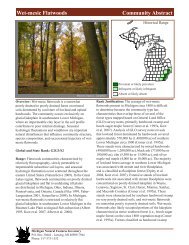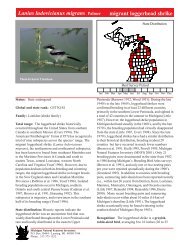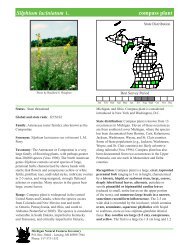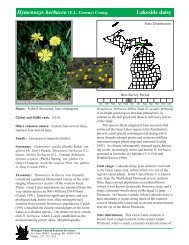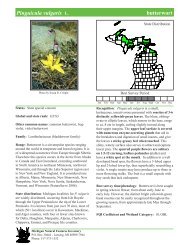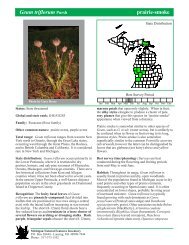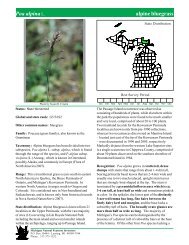Sander Canadensis Smith Sauger - Michigan Natural Features ...
Sander Canadensis Smith Sauger - Michigan Natural Features ...
Sander Canadensis Smith Sauger - Michigan Natural Features ...
You also want an ePaper? Increase the reach of your titles
YUMPU automatically turns print PDFs into web optimized ePapers that Google loves.
<strong>Sander</strong> canadensis <strong>Smith</strong> <strong>Sauger</strong><br />
Courtesy of John Lyons<br />
Status: State Threatened<br />
Global and state rank: G5/S1<br />
Family: Percidae (perch and darters)<br />
Total range: <strong>Sauger</strong> are native to the St. Lawrence –<br />
Great Lakes, Hudson Bay, and Mississippi River basins<br />
from Quebec to Alberta and south to the Tennessee<br />
River in Alabama and northern Louisiana. It has<br />
been introduced into the Atlantic, Gulf, and southern<br />
Mississippi River drainages (Page and Burr 1991, Scott<br />
and Crossman 1973).<br />
State distribution: Historically sauger were abundant<br />
in Lake Erie, Saginaw Bay, and less common in<br />
Lakes <strong>Michigan</strong>, Huron, and Superior and their main<br />
tributaries (Evers 1997). In the last 20 years, the sauger<br />
has been recorded in only the St. Clair River and Lake<br />
St. Clair.<br />
Recognition: The sauger is an elongate, cylindrical<br />
fish from the perch family with large canine teeth<br />
(<strong>Smith</strong> 1979). They are yellowish-olive or gray with<br />
three to four widely spaced dusky saddles that extend<br />
down each side (<strong>Smith</strong> 1979). The main distinguishing<br />
characteristics of the sauger are the rows of distinct,<br />
dusky spots on the first dorsal fin and the black spot<br />
at the base of the pectoral fin (<strong>Smith</strong> 1979, <strong>Smith</strong><br />
1985). <strong>Sauger</strong> have two obviously separated dorsal<br />
fins, the first has 12-13 spines and is triangular in<br />
<strong>Michigan</strong> <strong>Natural</strong> <strong>Features</strong> Inventory<br />
P.O. Box 30444 - Lansing, MI 48909-7944<br />
Phone: 517-373-1552<br />
State Distribution<br />
shape whereas the second dorsal has one fine spine and<br />
16-21 rays and is higher or as high as the first dorsal<br />
(Scott and Crossman 1973, Trautman 1981). They<br />
have a complete lateral line with 82-100 scales (Scott<br />
and Crossman 1973). <strong>Sauger</strong> have 5-8 pyloric caeca<br />
(finger-like pouches at the junction of the stomach and<br />
intestine).<br />
The sauger looks very similar to the walleye but the<br />
sauger has many black spots on the first dorsal fin<br />
whereas the walleye has a single large black spot at the<br />
rear of the first dorsal and a white spot at tip of lower<br />
caudal lobe (Page and Burr 1991).<br />
Best survey time/phenology: <strong>Sauger</strong> are best surveyed<br />
for at night.<br />
Habitat: The sauger can be found in lakes, reservoirs,<br />
and large rivers (<strong>Smith</strong> 1985) and seem to prefer<br />
systems that are turbid. The turbidity “may prevent<br />
excessive egg adhesion and thereby reduce suffocation,<br />
protect young from predators, and facilitate feeding<br />
of young by concentrating plankton near the surface”<br />
(Scott and Crossman 1973). <strong>Sauger</strong> generally prefer<br />
systems where temperatures in the entire water column<br />
are within their temperature preferences (Scott and<br />
Crossman 1973).<br />
Biology: <strong>Sauger</strong> spawn over gravel/rubble shoals in<br />
May or June when temperatures are around 3.9-6.1°C<br />
(Scott and Crossman 1973, <strong>Smith</strong> 1985). <strong>Sauger</strong> do not
uild nests but broadcast adhesive, demersal (sinking)<br />
eggs over shoals in 0.6-3.6m of water at night (Scott<br />
and Crossman 1973, <strong>Smith</strong> 1985). The males typically<br />
arrive at spawning shoals before females. Spawning<br />
takes place in about a 2 week period. The recently<br />
hatched sauger spend between 7 and 9 days along the<br />
bottom absorbing yolk (Scott and Crossman 1973).<br />
<strong>Sauger</strong> can live up to 13 years and become sexually<br />
mature between 2-3 years for males and 4-6 years for<br />
females (Scott and Crossman 1973).<br />
<strong>Sauger</strong> are sight predators and exhibit negative<br />
phototropism, meaning they tend to say away from<br />
light, and so feed at night in clearer waters and may<br />
feed throughout the day in more turbid waters (Schlick<br />
1978). Young sauger mainly feed on zooplankton and<br />
aquatic insect larvae (Scott and Crossman 1973, Hesse<br />
1994). Adult sauger feed on fish and invertebrates,<br />
specifically gizzard shad, emerald shiner, crappie, bass,<br />
freshwater drum, leeches, crayfish, and insects (Scott<br />
and Crossman 1973, Fitz and Holbrook 1978, Rawson<br />
and Scholl 1978, <strong>Smith</strong> 1985, Walh and Nielsen 1985).<br />
In the Ohio River, gizzard shad and emerald shiner<br />
were the most common prey of sauger, followed by<br />
freshwater drum, channel catfish, and mimic shiners.<br />
Emerald shiners are an important component of sauger<br />
diets during most of the year, declining somewhat from<br />
October to January. In the spring, invertebrates are<br />
their staple. From September through January gizzard<br />
shad make up a large component of sauger diets and<br />
freshwater drum and channel catfish become large<br />
components of the diet in July and August. The most<br />
rapid period of growth for sauger is during September<br />
to March (Walh and Nielsen 1985). Females typically<br />
grow faster and are larger than males (Fitz and<br />
Holbrook 1978).<br />
<strong>Sauger</strong> tend to have considerable population<br />
fluctuations (Hackney and Holbrook 1978). They<br />
are often found in systems with highly diverse fish<br />
communities and where yellow perch and walleye are<br />
not as common (Clady 1978).<br />
Movements: <strong>Sauger</strong> can have extensive movements,<br />
especially during their spawning season (Jeffrey and<br />
Edds 1999). They have been known to move up to 380<br />
km (Collette et al. 1977).<br />
Interesting note: The sauger mainly feeds at night or<br />
during twilight hours. They are able to do this because<br />
of a special structure in their eye called the tapetum<br />
<strong>Michigan</strong> <strong>Natural</strong> <strong>Features</strong> Inventory<br />
P.O. Box 30444 - Lansing, MI 48909-7944<br />
Phone: 517-373-1552<br />
sauger, Page 2<br />
lucidum. This is a reflective structure in the eye that<br />
acts like a mirror and reflects light back through the<br />
retina, giving the retina two chances to catch the light.<br />
Conservation and management: Over-fishing and<br />
environmental degradation are often blamed for the<br />
saugers decline (Rawson and Scholl 1978). However,<br />
these reasons are not always agreed upon. Evers<br />
(1994) suggests that due to the saugers tolerance of<br />
turbidity, their population declines are not likely related<br />
to habitat degradation. There is also debate as to<br />
whether competition with walleye has aided in sauger<br />
declines. Management targeted towards restoring<br />
and/or preserving spawning and other critical habitats is<br />
needed.<br />
Research needs: Identification of spawning grounds<br />
and other critical habitats is crucial for the effective<br />
managment of sauger. In addition, more information is<br />
needed on why sauger have declined in the Great Lakes<br />
region. A better understanding of sauger and walleye<br />
interactions in the Great Lakes is also important for<br />
effective management.<br />
Selected references:<br />
Clady, M.D. 1978. Structure of fish communities<br />
in lakes that contain yellow perch, sauger, and<br />
walleye populations. American Fisheries Society<br />
Special Publication 11: 11-108.<br />
Collette, B.B., M.A. Ali, K.E.F. Hokanson, M. Nagiec,<br />
S.A. Smirnov, J.E. Thorpe, A.H. Weatherly, and<br />
J. Willemsen. 1977. Biology of the percids.<br />
Journal of the Fisheries Research Board of<br />
Canada 34: 1890-1899.<br />
Evers, D.C. 1994. Fish: species accounts. In D.C.<br />
Evers, ed., Endangered and threatened wildlife<br />
in <strong>Michigan</strong>. University of <strong>Michigan</strong> Press,<br />
Ann Arbor, MI, p. 265-267.<br />
Fitz, R.B. and J.A. Holbrook II. 1978. <strong>Sauger</strong> and<br />
walleye in Norris Reservior, Tennessee.<br />
American Fisheries Society Special Publication<br />
11: 82-88.<br />
Hackney, P.A. and J.A. Holbrook II. 1978. <strong>Sauger</strong>,<br />
walleye, and yellow perch in the southeastern<br />
United States. American Fisheries Society<br />
Special Publication 11: 74-81.
Hesse, L.W. 1994. The status of Nebraska fishes in<br />
the Missouri River. 6. sauger (Percidae:<br />
Stizostedion candense). Transactions of the<br />
Nebraska Academy of Sciences 21: 109-121.<br />
Jeffrey, J.D. and D.R. Edds. 1999. Spring movements<br />
and spawning habitat of sauger (Stizostedion<br />
canadense) in a small Midwestern USA<br />
reservoir. Journal of Freshwater Ecology 14(3):<br />
385-397.<br />
Page, L.M. and B.M. Burr. 1991. A field guide to<br />
freshwater fishes: North American north of<br />
Mexico. Houghton Mifflin Company, Boston,<br />
Massachusetts. 432 pp.<br />
Rawson, M.R. and R.L. Scholl. 1978. Reestablishment<br />
of sauger in western Lake Erie. American<br />
Fisheries Society Special Publication 11: 261-<br />
265.<br />
Scott, W.B. and E.J. Crossman. 1973. Freshwater<br />
fishes of Canada. Bulletin 184, Fisheries<br />
Research Board of Canada, Ottawa, 966 pp.<br />
<strong>Smith</strong>, C.L. 1985. The inland fishes of New York<br />
State. New York State Department of<br />
Environmental Conservation, Albany, NY. 522<br />
pp.<br />
<strong>Smith</strong>, P.W. 1979. The fishes of Illinois. University of<br />
Illinios Press, Urbana. 314 pp.<br />
Trautman, M.B. 1981. The fishes of Ohio. Ohio State<br />
University Press. 782 pp.<br />
Wahl, D.H. and L.A. Nielsen. 1985. Feeding ecology<br />
of the sauger (Stizostedion canadense) in a<br />
large river. Canadian Journal of Fisheries and<br />
Aquatic Sciences 42:120-128.<br />
Abstract citation:<br />
Derosier, A.L. 2004. Special Animal Abstract for <strong>Sander</strong><br />
<strong>Canadensis</strong> (sauger). <strong>Michigan</strong> <strong>Natural</strong> <strong>Features</strong><br />
Inventory. Lansing, MI. 3 pp.<br />
<strong>Michigan</strong> <strong>Natural</strong> <strong>Features</strong> Inventory<br />
P.O. Box 30444 - Lansing, MI 48909-7944<br />
Phone: 517-373-1552<br />
sauger, Page 3<br />
Copyright 2004 <strong>Michigan</strong> State University Board of Trustees.<br />
Funding provided by the National Oceanic and Atmospheric<br />
Administration (NOAA) Coastal Services Center via the<br />
Great Lakes Commission.<br />
<strong>Michigan</strong> State University Extension is an affirmative-action,<br />
equal-opportunity organization.



